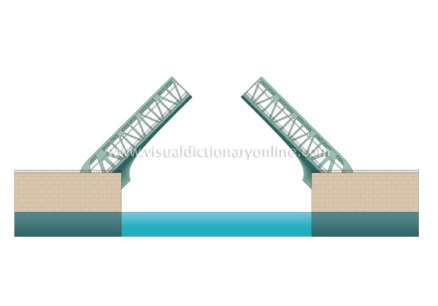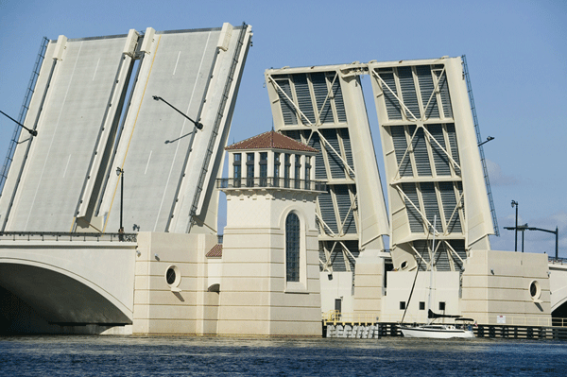“DOUBLE LEAF BASCULE BRIDGE”
Table OF CONTENTS
1. OBJECTIVE…………………………………………..…………3
2. INTRODUCTION…………………………………..…………3
3. METHOD…………………………………………….….………3-4
4. DISCUSSION……….……………………………………… … 5-8
5. CONCLUSION……………………………………………..9-10
6. REFRENCES…………………………………………………11
1.Aim:
- Become familiar with the wood work.
- Become familiar with lathe machine and boring machine.
- Construct a simple block.
2. Introduction:
A bascule span ( normally referred to as a lift bridge ) is a movable span with a counterbalance that continuously balances a span, or “ foliage, ” throughout its upward swing to supply clearance for boat traffic. It may be individual or dual leafed.
3. Method:
- Cut out an arch with the coil proverb from the 5-by-7-by-2-inch block of pine wood. Make the arch about 3 inches broad and 4 inches high. Be certain to cut in the longest way, so that the underside of the arch becomes the underside of the tower, and there is 3 inches left above the top of the arch.
- Measure and grade with the pencil every 1/2 inch across the top of the tower, above the arch. At every other grade, cut a notch 1/2 inch deep and 1/2 inch broad with the coil proverb. These are the tower crenelations.
- Center the tower on the 5-by-10-by-1/2-inch block and nail the two pieces together through the underside to organize the tower base.
- Lay down the two 4-by-1/2-by-1/2-inch blocks parallel to each other 3 inches apart on your work surface.
- Lay the eight 4-by-1/2-by-1/8-inch strips across the two blocks. Attach the strips to the blocks with completing nails. This is your lift bridge.
- Bend over the lift bridge and pat in two coating nails, one into each block, as near to the terminals as you can without dividing the wood. Leave the nails lodging out past the borders of the lift bridge, approximately 1/4 inch. This will be the pivot terminal of your gate.
- Tap in two more coating nails, one into each block, about 1/2 inch from the terminal opposite the pivot terminal of the lift bridge. Leave the nails lodging past the borders about 1/4 inch.
- Lay the lift bridge, barricade side down, on the tower base in forepart of the tower. Place an upholstery basic over the protruding nails on the pivot terminal and gently tap the basics into the tower base. This should keep the lift bridge in topographic point while leting it to revolve freely into unfastened and unopen places. Adjust the basics and nails if needed.
- Tap two completing nails into the tower, one on either side at the top of the arch. Make certain they are separated 4 inches apart, every bit broad as the lift bridge. Angle the nails at about 45 grades, and leave half of each nail lodging up.
- Attach one terminal of each concatenation to the nails at the top of the arch. Attach the other terminals to the lift bridge.
- Stain the wood with the paintbrush, so let to dry.
4. Discussion:
- SAMPLE DIAGRAM:
- TERMS AND EXPLANATION:
- Practical Information ABOUT BASCULE BRIDGES:
About all dual foliage bascule Bridgess consist of two cantilever spans projected toward each other, connected at their tips by a suited shear lock. Other types of dual foliage bascule are relatively rare, such as those which form arch Bridgess in the closed place, and are non the subject of this treatment.
Double foliage bascule Bridgess are perchance the least practical, from a care and operation point of view, of all normally used types of modern epoch movable Bridgess. They use two separate traveling foliages when 1 would make, with all the associated disbursal in building, operation, and care of two wholly independent movable span foliages. They besides join these two traveling foliages together for the support of unrecorded burden, intensifying the troubles. There are advantages to duplicate leaf bascules: they can open and shut slightly more rapidly than any other type of movable span ; a dual foliage bascule is less affected by air current tonss than a individual foliage bascule crossing the same channel breadth ; they use somewhat less structural steel than other types of movable Bridgess with the same burden evaluation crossing the same breadth of pilotage channel ; dual foliage bascules are less susceptible to hit with vass voyaging past them than other movable span types, and they are by and large considered more aesthetically delighting than other types of movable Bridgess. One might inquire, nevertheless, whether these advantages are deserving seting up with the extra complications, peculiarly in respect to stabilising the constructions under unrecorded burden.
Double foliage bascule Bridgess, more so than most other movable span types, often have jobs with siting. These jobs arise from several beginnings. The span may be transporting unrecorded tonss larger than those designed for, overemphasizing the support system. The span stabilising devices may hold suffered impairment so that they can non incorporate the forces imposed on them. The span stabilising devices may be improperly adjusted so that they do non execute their intended map. The entities which contribute to stableness of a dual foliage bascule include: unrecorded burden places which form Michigans for each traveling foliage as it attains its sitting place ; centre or shear locks organizing a perpendicular tie between the two foliages of a dual foliage bascule span when in the closed place ; unrecorded burden ground tackles which are capable of exercising a downward force at the rear of span counterbalance ; tail locks Which form a shear connexion at or near the rear of the span counterbalance, and accommodation of the balance of the traveling foliage about its axis of rotary motion.
Bascule is Gallic for see-saw. All modern bascule Bridgess consist of a big traveling mass of superstructure, deck, and counterbalance, which can be considered balanced for structural intents. The span can be considered basically stiff for equilibrating intents, as it rotates between opened and closed places. This applies whether it is a simple trunnion foliage, or a rolled lift of the Scherzer or Ball type. It besides applies to the many fluctuations on the articulated counterbalance type, as developed by Strauss and others, with the counterbalance swiveling about an axis or arc separate from the span foliage. An exclusion to this regulation are bascules with operating prances or ropes such as many heel trunnions, some early Scherzer turn overing lifts, and others, which do non add merely to the reconciliation computations, as they move in a different way than the superstructure. The operating prance could be heavy plenty to hold a noticeable consequence on the balance, but this normally merely happens with individual foliage railway Bridgess. Heel trunnion and articulated counterbalance bascule Bridgess have the counterbalance revolving about an axis offprint from the foliage itself. The counterbalance is ever in a fixed place with respect to gravitative minute relation to the bascule span on these Bridgess, due to the parallelogram agreement of the pivot points.
Double foliage bascule bridges become unstable because they are ill designed, ill constructed, or ill maintained. They are more susceptible to lacks from these causes because they are more delicate than other common types of movable Bridgess. It is really hard to rectify the mistakes of a ill designed span, but sometimes possible to rectify building defects. It is really hard to rectify the consequences of hapless care except by replacing the constituents affected. A decently designed dual foliage bascule span should be really stiff, peculiarly in respect to primary unrecorded burden warps.
The foliages of the dual foliage bascule should be steadfastly supported on really solid unrecorded burden places located next to the wharf sea wall, every bit far as possible from the centre of rotary motion.
The balance of the dual foliage bascule should be such that a dead burden reaction exists on the unrecorded burden places, when the span is closed, that is well in surplus of any possible negative reaction, from unrecorded burden or other beginnings. The roadway surfaces of the dual foliage bascule should be formed so that there is no misalignment at the articulations, either at the heels of the foliages or at the toes. This applies to profile every bit good as lift – the perpendicular curve should be uninterrupted from one foliage to the other and from each foliage to its attack. Tail locks should be provided as a backup to the stabilisation achieved by equilibrating. The tail locks should firmly hold on the tail terminal of each foliage with minimal clearances and keep it in the closed place. This will extinguish the possibility of drive machinery being damaged due to populate burden warp.
- BRIDGE DESIGN IN THIRD ANGLE OF PROJECTION:
- CONCLUSION AND RECCOMENDATION:
Double foliage bascule bridges become unstable because they are ill designed, ill constructed, or ill maintained. They are more susceptible to lacks from these causes because they are more delicate than other common types of movable Bridgess. It is really hard to rectify the mistakes of a ill designed span, but sometimes possible to rectify building defects. It is really hard to rectify the consequences of hapless care except by replacing the constituents affected. A decently designed dual foliage bascule span should be really stiff, peculiarly in respect to primary unrecorded burden warps.
The foliages of the dual foliage bascule should be steadfastly supported on really solid unrecorded burden places located next to the wharf sea wall, every bit far as possible from the centre of rotary motion.
The balance of the dual foliage bascule should be such that a dead burden reaction exists on the unrecorded burden places, when the span is closed, that is well in surplus of any possible negative reaction, from unrecorded burden or other beginnings. The roadway surfaces of the dual foliage bascule should be formed so that there is no misalignment at the articulations, either at the heels of the foliages or at the toes. This applies to profile every bit good as lift – the perpendicular curve should be uninterrupted from one foliage to the other and from each foliage to its attack. rail locks should be provided as a backup to the stabilisation achieved by equilibrating. The tail locks should firmly hold on the tail terminal of each foliage with minimal clearances and keep it in the closed place. This will extinguish the possibility of drive machinery being damaged lue to populate burden warp.
Movable Bridgess have been an of import portion of our nation’s
Infrastructure for centuries. They present alone challenges to the structural applied scientist and necessitate extended coordination of the
structural, mechanical, and electrical systems to accomplish a lasting and operationally dependable construction.
FINAL Undertaking:
- REFERNCES:
hypertext transfer protocol: //en.wikipedia.org/wiki/Bascule_bridge
hypertext transfer protocol: //heavymovablestructures.org/assets/technical_papers/00525.pdf






